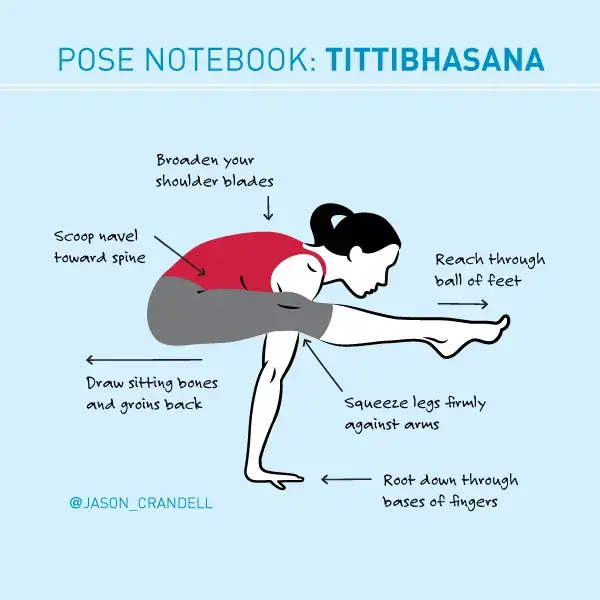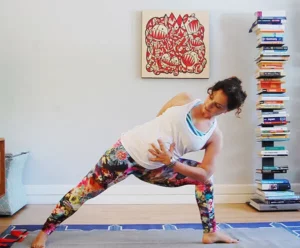HOW TO USE THIS BLOG:
1. Simply practice Tittibhasana using the illustration above.
2. You can learn the steps get into Tittibhasana in the “How To” section.
3. Or you can geek out on the sequencing and anatomy details for Tittibhasana (Firefly Pose) by skipping down to Part II.
Don’t forget to pass this along to your students and colleagues!
If you want to learn more, join me for my 500-hour Certification Program or for my workshops, Mastering the Art of Yoga Sequencing and Managing Yoga Injuries.
GETTING INTO TITTIBHASANA
The key to doing Tittibhasana is being light, strong (everywhere), flexible (everywhere), balanced—and, if possible—young (twenties would be nice). If this sounds like you, stop reading and go do the pose, OK?
If, however, you can’t relate to the above characterisitics—and I certainly can’t—the pose is pretty tough. It’s doable, but skillful preparation is paramount.
Tittibhasana is a balancing pose and it works a little bit like an old-fashioned scale. So, you’ll need to let the weight of your pelvis drop down and back behind your elbows to help you lift your feet off the floor. Let’s take a closer look:
WARMING UP FOR TITTIBHASANA
It’s a good idea to open the hamstrings, adductors, and outer hips before launching into Tittibhasana. It’s also wise to do a few core strengthening poses to warm-up your hip flexors and abdominals. (Read Part II if you want specific suggestions, otherwise, I’ll leave the preparations to your choosing.)
HOW TO PRACTICE TITTIBHASANA
1. Take your feet a little wider than your hips and rotate your feet slightly outward.
2. Forward bend and tuck your shoulders behind your knees. With you hands, hold the back of your ankles.
3. Take a couple of breaths, folding more deeply and easing your shoulders behind your knees. Be mindful of your lower back and sacrum. If they’re uncomfortable with the forward bend, come out of the pose and work on your hamstrings, inner legs, and outer hips in more accommodating postures.
4, Place your hands behind your heels with your fingers pointing forward. Look at your thumbs and make sure they’re not in a crazy position (you’ll know what I mean when you do it). If your hands don’t come all the way to the floor, they may in the next step. If they don’t come to floor in the next step, you can put a wedge or folded mat under the heel of your palm. If you need something higher, it means that your hips aren’t quite ready for this pose—stick to leg-opening postures for now.
5. With your fingers facing forward, bend your knees and your elbows, sitting back so the weight of your pelvis is on your arms.
6. Squeeze your legs against your arms, lift your feet, and straighten your legs. Focus on reaching your legs straight forward while you squeeze the inner legs toward the midline to minimize how wide your legs go.
7. Now that you’re in the pose, work on the key teaching points in the infographic above!
8. If you’ve crashed and burned, get up and give it another go. If the pose feels impossible, content yourself with a few more weeks or months of preparations.
IF I CAN’T DO TITTIBHASANA YET, WHAT SHOULD I DO INSTEAD?
If you still need to build strength for the pose, practice a combination of core, shoulder, and arm strengtheners. Be consistent with Paripurna Navasana (Full Boat), Ardha Navasana (Half Boat), Plank, Chaturanga Dandasana (Four-Limbed Staff Pose), and Salabhasana (Locust). If you need more flexibility for Tittibhasana my three favorite preparations are Lizard Lunge, Prasarita Padottanasana (Wide-Legged Standing Forward Bend) and Upavistha Konasana (Wide-legged Seated Forward Bend). Bakasana (Crane) is also a great pose to practice if you’re unable to do Tittibhasana.
PART II: ANATOMY AND SEQUENCING FOR TITTIBHASANA
WHICH MUSCLES DOES TITTIBHASANA STRENGTHEN?
The short answer is your core, shoulders, and arms. Here’s a more detailed look:
Your abdominals and pelvic floor
All of your abdominal muscles engage to lift your pelvis and support the weight of your center. Most notably, your transverse abdominus draws your navel toward your spine and your rectus abdominus helps to maintain the slight flexion (rounding) of your spine.
Your hip flexors
Your psoas and rectus femoris fire strongly to flex your hips, keep your legs lifted and straighten your legs.
Your inner legs
One of the most challenging components of Tittibhasana is the dynamics of your inner-legs, or adductor muscles: You have to strongly engage the adductors to keep your legs from sliding down your arms. Ath the same time, the pose requires a deep stretch in these muscles.
Your shoulders
Tittibhasana works all of your shoulder muscles, specifically:
The rotator cuff muscles which help stabilize your arms.
The anterior deltoids and pectoralis which help you lift your body in the pose.
The scapular muscles (especially the serratus anterior) which help you broaden your upper back in the pose.
Your arms
Your triceps are working harder than any other muscle group in your arms here. Your forearm muscles also gain strength in this posture.
WHICH MUSCLES DOES TITTIBHASANA STRETCH?
Your hamstrings
Tittibhasana stretches all three hamstrings—especially the two medial hamstrings, your semitendinosus and semimebranosus.
Your adductors
All of your adductors engage, which enables you to both hug your legs against your arms and straighten your legs. The gracilis and adductor magnus, due to their functional relationship with the hamstrings, get the greatest stretch in this family of muscles.
Your outer hips
You may not feel your outer hips stretching nearly as much as your hamstrings or adductors. However, your gluteus maximus, piriformis, and other external rotators are working eccentrically. This means you engage them and lengthen at the same time! (The way you do when you lower a weight in a biceps curl.)
SEQUENCING FOR TITTIBHASANA (FIREFLY)
You can find a fully-illustrated, 16-pose sequence for Tittibhasana here.
{illustration by MCKIBILLO}



